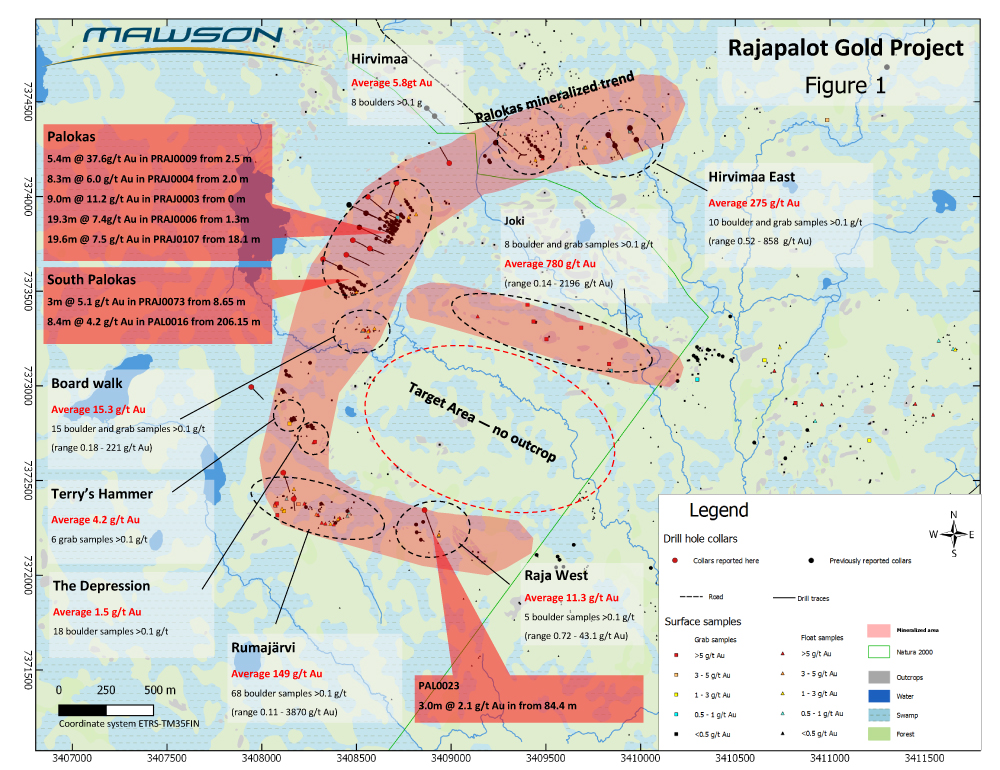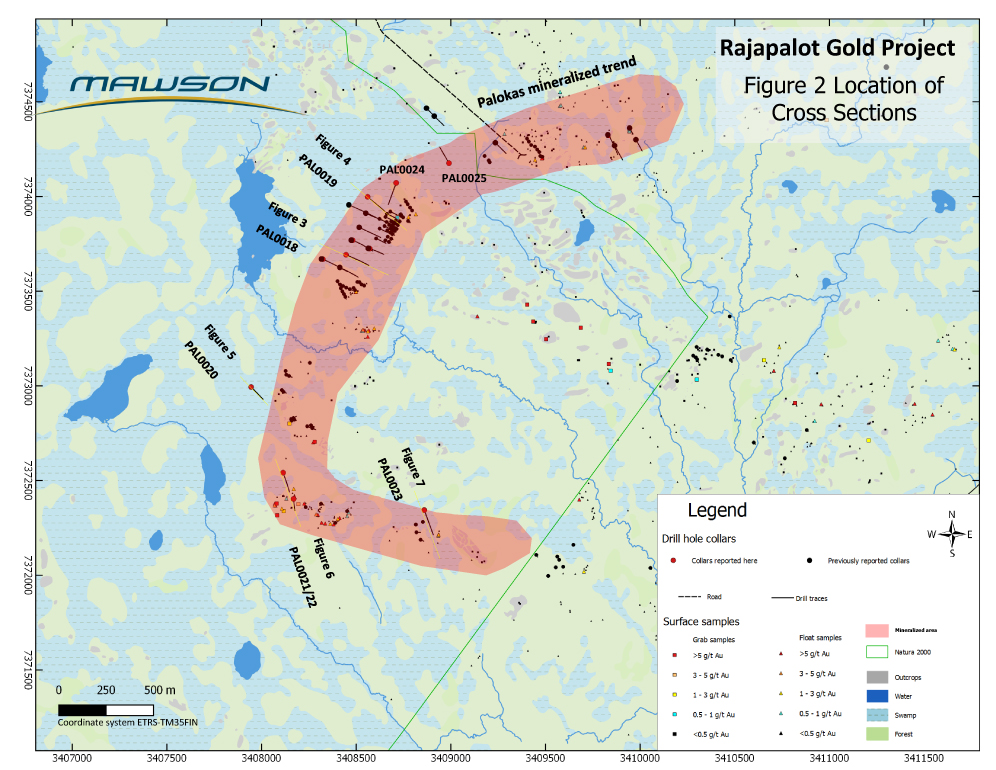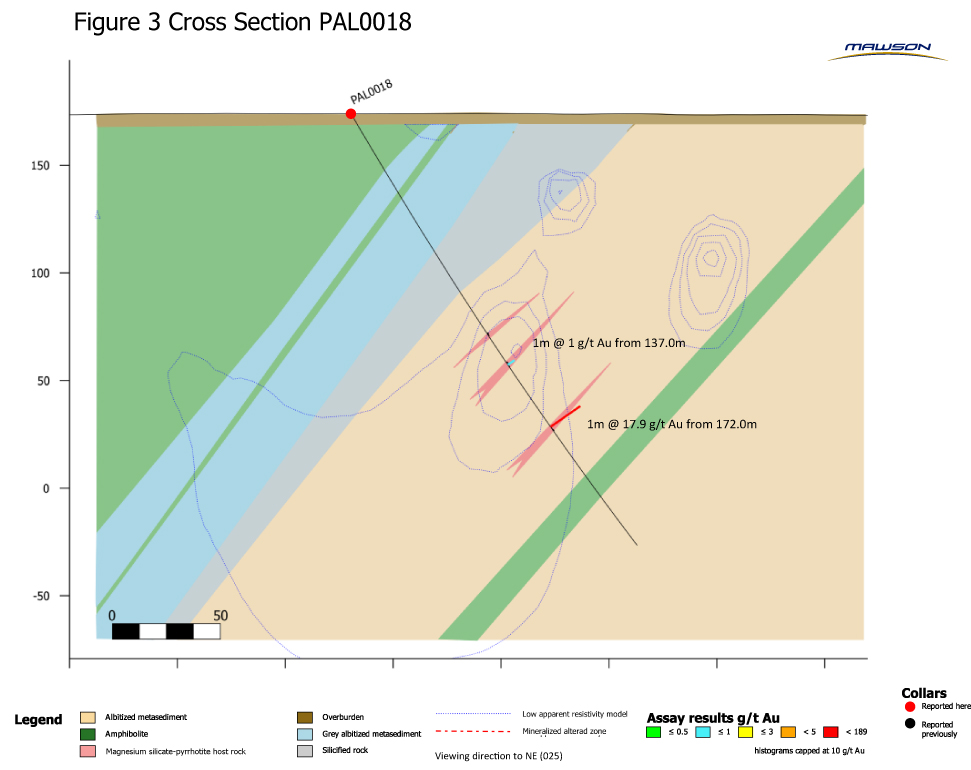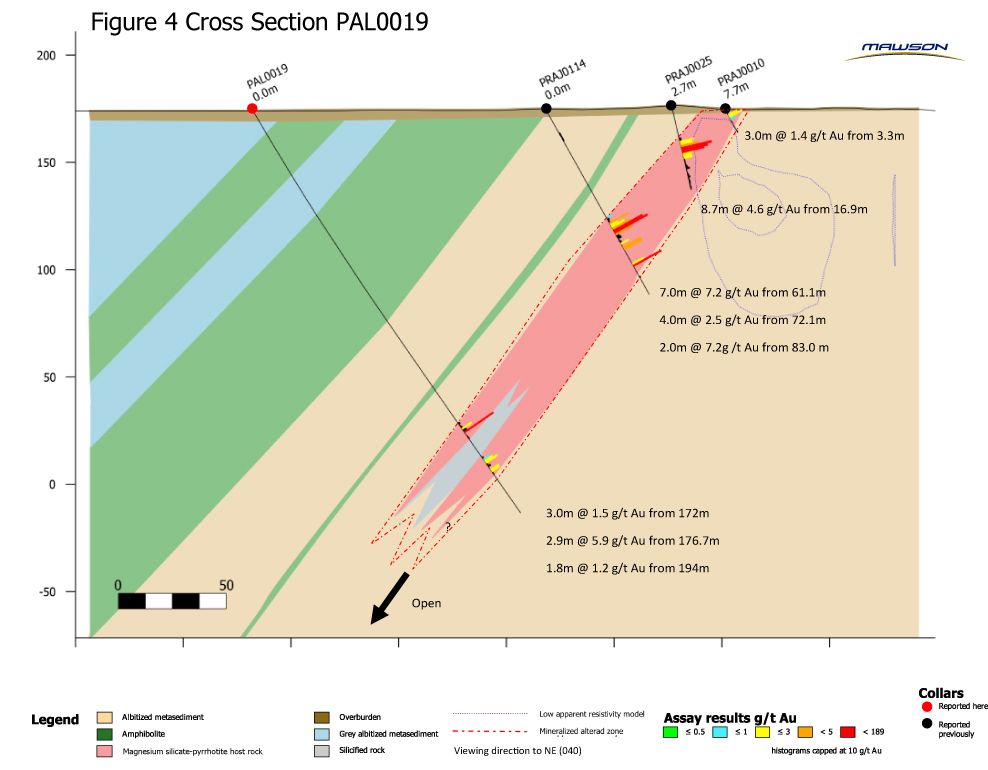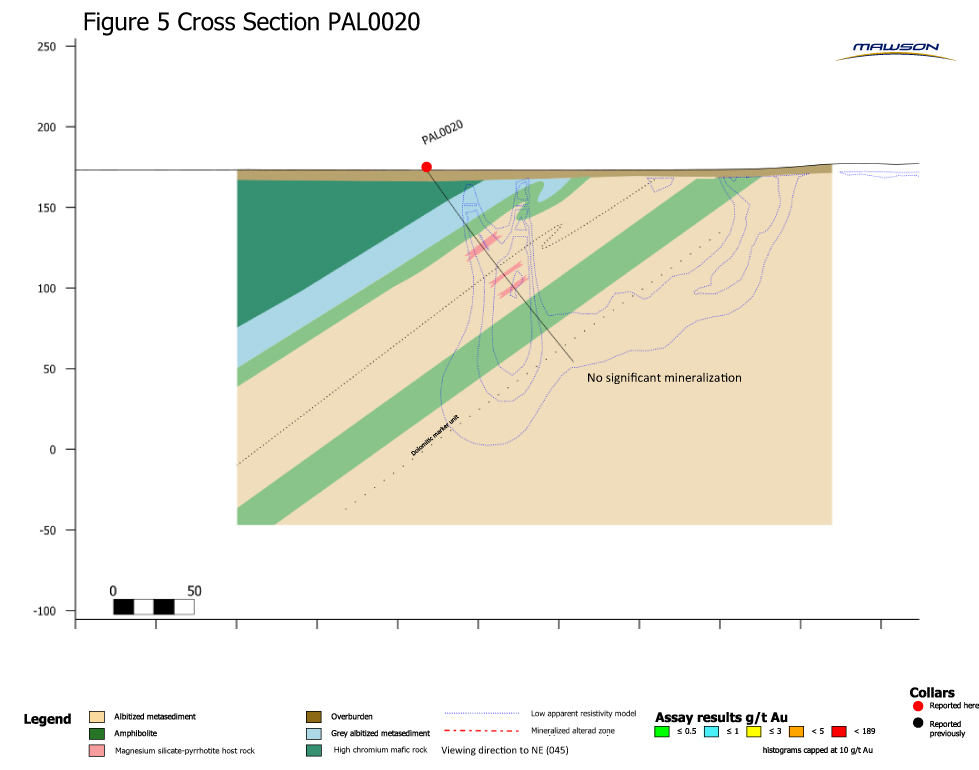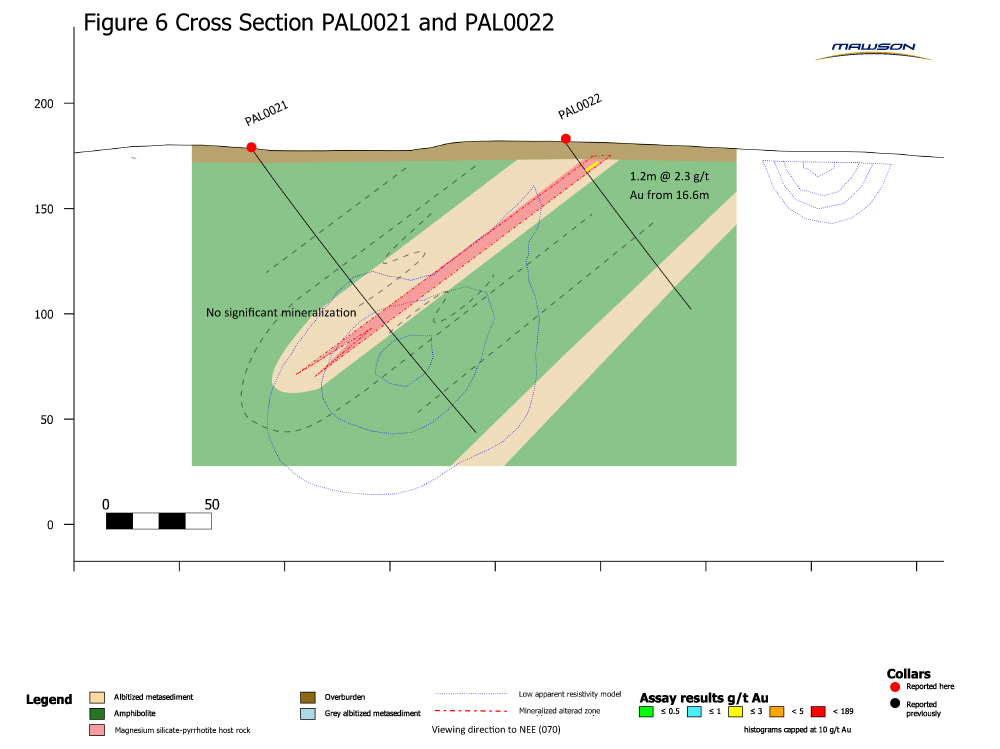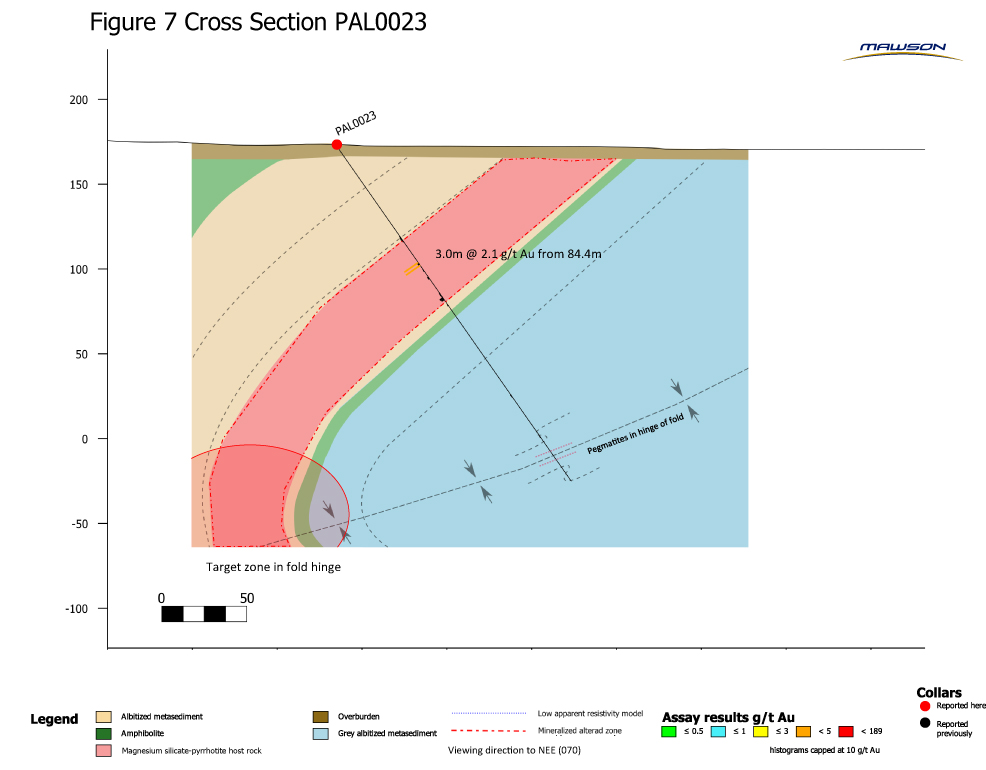Vancouver, Canada -- Mawson Resources Limited ("Mawson") or (the "Company") (TSX:MAW) (Frankfurt:MXR) (PINKSHEETS: MWSNF) provides an update on the final 8 drill holes (PAL0018-25) from the 16 hole, 3,386 metre winter drill program at the 100% owned Palokas gold project in Finland. Two hand-portable Energold Group EGD Series III rigs modified to meet environmental requirements and climate conditions were used for the drill program.
Key Points:
|
Mr Hudson, President & CEO states, "We are pleased, after the hard work of our team over many years, to have completed a successful first full winter drilling program. We have discovered a large gold mineralized system, within an area of 100 square kilometres, of a type previously unrecognized in Finland. The new data received from this program allows us to move forward with confidence into the summer season, with a greater understanding of the three dimensional nature of this exciting project. This winter's drill program supports the large scale of the mineralized system at Palokas, now drilled over 3.6 kilometres, with multiple mineralized positions discovered. With the majority of the target area still untested, the project demands significantly more drilling to constrain and define further mineralization."
The winter drill program completed 16 holes for 3385.7 metres at the Hirvimaa and Palokas prospects plus one abandoned and one short test hole. Tables 1 and 2 include collar and best assay results to date from the winter drill program. The true thickness of mineralized intervals is interpreted to be approximately 90% of the sampled thickness. Plan maps of drilling and gold results are shown in Figures 1 and 2, with representative cross sections shown in Figures 3 to 7.
Although structural control is difficult to establish with minimal outcrop and limited drilling, it appears gold is controlled by an interplay between quartz veins, gold in fractures and isoclinally folded host rocks. Consequently, the exploration target may be more attenuated than previously interpreted, with the target size increased across multiple potential ore positions.
A summary of holes reported here includes:
- Drill hole PAL0018 (Figure 3) was a single hole test on a section located 110 metres north of PAL0016 (8.4m @ 4.2 g/t Au in PAL0016 from 206.15 metres) and 250 metres south of the main Palokas mineralization. PAL0018 intersected a 110 metre thick altered package, which included the presence of visible gold at both 137.2 metres and 170.3 metres. Best results were 1.0 metres @ 1.0 g/t from 137.0 metres and 1.0 metre @ 17.9 g/t gold from 172 metres.
- PAL0019 (Figure 4) drilled 2.9 metres @ 5.9 g/t gold from 176.7 metres, including 1.0 metre @ 16.7 g/t gold from 178.7 metres. This was a successful test of the downhole plunge of mineralization at Palokas, located 120 metres down dip from the earlier drilled PRAJ0114 (7.0 metres @ 7.2 g/t gold from 61.1 metres).
- PAL0020 (Figure 5) was a single hole test on a section to test the Palokas stratigraphic position, located 1.1 kilometres south of PAL0016 (8.4m @ 4.2 g/t Au in PAL0016 from 206.15 metres). The hole commenced in a well-defined mafic rock, then passed through magnesium silicate-altered rocks, followed by calcsilicate-bearing albitites with amphibolite. Gold mineralization was not intersected, but the near-miss alteration style is interpreted to be favourable for targets in the near vicinity.
- PAL0021 and PAL0022 (Figure 6) were drilled to test the Rumajärvi boulder field which contains 68 boulders and subcrops >0.1 g/t gold which range from 0.11 g/t gold to 3,870 g/t gold with an average of 101.4 g/t gold and median of 0.6 g/t gold. Although PAL0022 interested 1.2 metres @ 2.3 g/t gold, both holes failed to intersect the gold bearing host rocks and the source of the mineralized boulders remains to be discovered.
- PAL0023 (Figure 7) is significant in an exploration sense as it is located 2 kilometres from Palokas, and is the most easterly hole drilled along the Palokas target horizon. The main Palokas mineralized position was found within a 100-metre thick hydrothermally altered talc-silicified-pyrrhotite-amphibole rock with the best result of 3.0 metres @ 2.1 g/t gold from 84.4 metres. In this case the host sequence is inverted, confirming the inferred polydeformed, open to tightly folded rocks. This increases the project complexity, but increases the volume of potential host rock within the target area. Zones of additional structural complexity, such as the interaction of fold hinges with brittle, gold-mineralizing fractures and veins provide excellent targets for the future.
- PAL0024 was drilled to test a proposed westerly plunge to mineralization at Palokas. It failed to test the target.
- PAL0025 was drilled to test a strong VTEM anomaly at South Hirvimaa. It remained in the hanging wall sequence and failed to test the target as it appears the conductor is dipping away from the drillhole.
The 2016 summer-autumn program, which will start in June 2016, will consist of:
- Base of till drilling outside Natura 2000 areas to aid in targeting gold at both the Palokas and Rompas prospects (located 8 kilometres east) with a best drill result of 6 metres at 617g/t gold from 7 metres in drill hole ROM0011 which includes 1 metre at 3,540g/t gold from 11 metres depth;
- Winkie drilling down to 100 metres depth will recommence from August 2016;
- Field mapping within the newly defined target areas;
- Continued baseline mapping of species, habitats and vegetation.
- Larger scale drilling, subject to final permitting and when the ground freezes, from December 2016.
Mawson, in conjunction with all environmental authorities, ensured that all parts of the exploration programs were undertaken with minimal environmental impact. Baseline mapping of species, habitats and vegetation are undertaken during each summer and autumn. Mapping and identifying the nature values of the area ensures that threatened and endangered species are not negatively affected by exploration activities.
In other news, on August 24 2015, the Company announced that it requested a police investigation into certain accusations made by the Finnish Nature Conservation Association Lapland District ("NGO") in its appeal to Supreme Administrative Court on an earlier ruling made by the Regional Administrative Court in May 2015. The NGO made false claims that the Company had performed deep drilling inside Natura 2000 areas before permitting had been completed. After almost 6 months after filing the re-appeal and commencement of the police investigation, the NGO retracted their false accusations. Subsequently, the Company was informed by the Rovaniemi Police that the investigation was closed on April 07, 2016. The Company is pleased that the retraction was eventually provided. Unfortunately, Mawson has lost one year of research in the appeal process, and significant employment opportunities because of false allegations. While too late for this current legal process, Mawson also welcomes the Finnish Government's New Governmental Coalition Program, which limits access to the Supreme Administrative Court in environmental and construction matters.
Technical and Environmental Background
The qualified person for Mawson's Finnish projects, Mr Michael Hudson, President & CEO for Mawson and Fellow of the Australasian Institute of Mining Metallurgy has reviewed and verified the contents of this release.
Two Energold Group ("Energold) EGD Series III rigs which have been modified to meet environmental requirements and climate conditions were used for the drill program. Core diameter is NTW (56 mm) diameter core. Core recoveries were excellent and average close to 100% in fresh rock. After photographing and logging, core intervals averaging 1 metre in length for mineralized samples and 2 metres for barren samples were cut in half at the Geological Survey of Finland (GTK) core facilities in Rovaniemi, Finland. The remaining half core is retained on site for verification and reference purposes. Analytical samples were transported by Mawson personnel or commercial transport from site to the CRS Limited facility in Kempele, Finland. Samples were prepared at Kempele and analyzed for gold at Raahe using the PAL1000 technique which involves grinding the sample in steel pots with abrasive media in the presence of cyanide, followed by measuring the gold in solution with flame AAS equipment. The QA/QC program of Mawson consists of the systematic insertion of certified standards of known gold content, and blanks at the within interpreted mineralized rock. In addition, CRS inserts a number of blanks and standards into the analytical process.
About Mawson Resources Limited (TSX:MAW, FRANKFURT:MXR, PINKSHEETS:MWSNF)
Mawson Resources Limited is an exploration and development company. Mawson has distinguished itself as a leading Nordic Arctic exploration company with a focus on the flagship Rompas and Rajapalot gold projects in Finland.
| On behalf of the Board, "Michael Hudson" Michael Hudson, President & CEO |
Further Information www.mawsonresources.com 1305 - 1090 West Georgia St., Vancouver, BC, V6E 3V7 Mariana Bermudez (Canada), Corporate Secretary, +1 (604) 685 9316, info@mawsonresources.com |
Forward-Looking Statement
This news release contains forward-looking statements or forward-looking information within the meaning of applicable securities laws (collectively, "forward-looking statements"). All statements herein, other than statements of historical fact, are forward-looking statements. Although Mawson believes that such statements are reasonable, it can give no assurance that such expectations will prove to be correct. Forward-looking statements are typically identified by words such as: aim, believe, expect, anticipate, intend, estimate, postulate, and similar expressions, or are those, which, by their nature, refer to future events. Mawson cautions investors that any forward-looking statements are not guarantees of future results or performance, and that actual results may differ materially from those in forward-looking statements as a result of various factors, including, but not limited to, capital and other costs varying significantly from estimates, receipt of shareholder approval of the Placement, successful completion of the Placement, timing and the successful completion of an initial mineral resource estimate at the Rompas-Rajapalot prospect in Finland, changes in world metal markets, changes in equity markets, planned drill programs and results varying from expectations, delays in obtaining results, equipment failure, unexpected geological conditions, local community relations, dealings with non-governmental organizations, delays in operations due to permit grants, environmental and safety risks, and other risks and uncertainties disclosed under the heading "Risk Factors" in Mawson's most recent Annual Information Form filed on www.sedar.com. Any forward-looking statement speaks only as of the date on which it is made and, except as may be required by applicable securities laws, Mawson disclaims any intent or obligation to update any forward-looking statement, whether as a result of new information, future events or results or otherwise.
Table 1: Collar Information from Winter 2015/16 Energold drill program at the Palokas and Hirvimaa Prospects.
| Hole_ID | UTME | UTMN | RL | Dip | AzimUTM | Overburden Depth (m) | Depth (m) | Comment |
|---|---|---|---|---|---|---|---|---|
| PAL0008 | 3409235 | 7374248 | 175.0 | -60 | 130 | 4 | 158.4 | Reported Feb 24, 2016 |
| PAL0009 | 3408550.6 | 7373912 | 174.0 | -60 | 116 | 5.7 | 201.5 | Reported Feb 24, 2016 |
| PAL0010 | 3408460.7 | 7373955.6 | 173.9 | -60 | 116 | 5.3 | 285.95 | Reported Feb 24, 2016 |
| PAL0011 | 3409405.7 | 7374222 | 176.1 | -60 | 130 | 6.5 | 11.8 | Short test hole, no assays |
| PAL0012 | 3408515.6 | 7373837.4 | 174.0 | -60 | 116 | 4.9 | 233.55 | Reported Feb 24, 2016 |
| PAL0013 | 3408415.7 | 7373634.4 | 174.1 | -60 | 116 | 4 | 196.8 | Reported Feb 24, 2016 |
| PAL0014 | 3408333.1 | 7373666.1 | 174.0 | -60 | 116 | 0.8 | 19.9 | Reported Mar 07, 2016 Abandoned, no assays |
| PAL0015 | 3408570.6 | 7373725.4 | 174.6 | -60 | 116 | 4.05 | 151.9 | Reported Mar 07, 2016 |
| PAL0016 | 3408322 | 7373670 | 174.0 | -60 | 116 | 7.2 | 260.5 | |
| PAL0017 | 3408480 | 7373768 | 174.0 | -60 | 116 | 5 | 222.15 | |
| PAL0018 | 3408446 | 7373693 | 174 | -60 | 116 | 5.4 | 240.7 | Reported here |
| PAL0019 | 3408560 | 7373998 | 174 | -60 | 135 | 4.9 | 225.0 | Reported here |
| PAL0020 | 3407945 | 7372994 | 173 | -55 | 135 | 8.8 | 149.3 | Reported here |
| PAL0021 | 3408115 | 7372552 | 179 | -55 | 160 | 8.4 | 172.2 | Reported here |
| PAL0022 | 3408175 | 7372409 | 182 | -55 | 160 | 10.2 | 187.0 | Reported here |
| PAL0023 | 3408859 | 7372344 | 173 | -55 | 155 | 10.3 | 242.4 | Reported here |
| PAL0024 | 3408711 | 7374072 | 174 | -55 | 200 | 2.8 | 256.2 | Reported here |
| PAL0025 | 3408990 | 7374176 | 174 | -55 | 330 | 4.4 | 170.4 | Reported here |
Table 2: Bulk weighted assay data from the Palokas Prospect for the Energold winter 2015/16 drill program
A lower cut of 0.5 g/t over 2 metres was applied except hole PAL0013 where no lower cut was applied for 131.0-140.8m.
| Hole_id | From (m) | To (m) | Width | Au g/t | Comments |
|---|---|---|---|---|---|
| PAL0008 | 31.0 | 34.0 | 3.0 | 1.4 | |
| PAL0009 | 135.0 | 136.0 | 1.0 | 0.7 | |
| PAL0009 | 148.0 | 149.0 | 1.0 | 0.7 | |
| PAL0009 | 152.0 | 156.0 | 4.0 | 1.2 | |
| PAL0009 | 157.0 | 158.0 | 1.0 | 0.5 | |
| PAL0009 | 173.0 | 174.0 | 1.0 | 1.1 | |
| PAL0010 | No significant mineralization | ||||
| PAL0011 | Shallow test hole, no assays | ||||
| PAL0012 | 150.6 | 153.7 | 3.1 | 1.4 | |
| PAL0013 | 138.5 | 139.5 | 1.0 | 0.6 | |
| PAL0013 | 131.0 | 140.8 | 9.8 | 0.3 | |
| PAL0014 | Abandoned, no assays | ||||
| PAL0015 | No significant mineralization | ||||
| PAL0016 | 164.15 | 165.5 | 1.35 | 1.2 | |
| PAL0016 | 206.0 | 214.4 | 8.4 | 4.2 | Including 3.4 metres @ 9.5 g/t gold from 211.0 metres |
| PAL0017 | No significant mineralization | ||||
| PAL0018 | 137 | 138 | 1.0 | 1.0 | Visible gold @ 137.2 metres |
| PAL0018 | 172 | 173 | 1.0 | 17.9 | Visible gold @ 170.3 metres |
| PAL0019 | 176.7 | 179.6 | 2.9 | 5.9 | Including 1.0 metre @ 16.7g/t gold from 178.7 metres |
| PAL0019 | 194 | 197 | 3.0 | 1.5 | |
| PAL0019 | 200 | 201.8 | 1.8 | 1.2 | |
| PAL0020 | No significant mineralization -- in footwall | ||||
| PAL0021 | No significant mineralization | ||||
| PAL0022 | 16.6 | 17.8 | 1.2 | 2.3 | |
| PAL0023 | 84.4 | 87.4 | 3.0 | 2.1 | |
| PAL0024 | No significant mineralization | ||||
| PAL0025 | No significant mineralization |

